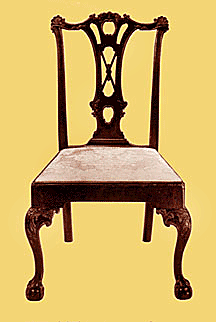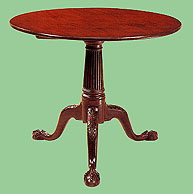And while cabinetmakers in Philadelphia used walnut and mahogany for
their designs, those in Bermuda used native cedar, stained to look like
mahogany. These Bermuda pieces can fool many collectors. However, the
cedar has a decidedly warm orange tinge to it which distinguishes it
from mahogany.
His book The Gentleman and Cabinet Maker's Director,
first published in 1754, was the most important collection of furniture
designs that had been issued in England. His furniture enriched England
from 1745 to 1770, and his influence was strong in this country from
1755 to 1790. Chippendale brought new and fresh ideas, but above all,
his furniture was always carefully fitted and joined. Mahogany, which
appeared about 1750, became his favorite wood. At first, it was often
finished to resemble walnut, the fashionable wood after 1702.
 Chippendale's designs fall into four general styles. One, using such
motifs as lions, masques, eggs, and darts, might be called English. For
a time, too, many of Chippendale's pieces borrowed from the rococo
appearance of French Louis XV furniture and were really an embellishment
of the simpler Queen Anne style by means of elaborate lines and touches.
Some of his designs reflected the Chinoiserie or Chinese style, with
pagoda motifs, bamboo turnings, the claw-and-ball foot, carved
latticework, and considerable lacquering, while others showed a Gothic
influence, featuring pointed arches, quatrefoils, and fret-worked legs.
Chippendale's designs fall into four general styles. One, using such
motifs as lions, masques, eggs, and darts, might be called English. For
a time, too, many of Chippendale's pieces borrowed from the rococo
appearance of French Louis XV furniture and were really an embellishment
of the simpler Queen Anne style by means of elaborate lines and touches.
Some of his designs reflected the Chinoiserie or Chinese style, with
pagoda motifs, bamboo turnings, the claw-and-ball foot, carved
latticework, and considerable lacquering, while others showed a Gothic
influence, featuring pointed arches, quatrefoils, and fret-worked legs.
He employed carving--which deep and sharp–as his chief decorative
technique. And he didn’t limit it to shell carving but extended it to
elaborate scrolls, foliage, and gadroons. Chippendale also used gilding,
some veneer, and fretwork galleries around small tables and the tops of
cabinet pieces as other forms of decoration.
Under Thomas Chippendale's guidance, bedsteads became less
pretentious although still handsome. This was the age of the four-poster
bed, and in this country at least the hangings were not quite so
all-enveloping. A short valance began to replace floor-length draperies.
Sometimes, he used a curtain across the back of the bed and perhaps side
curtains at the two rear posts. These beds became known as tester or
canopy beds. Sometimes a headboard came into sight.
Chippendale became especially known for his secretaries and desks.
The slant-top desk he designed had came with either a straight or
serpentine front.
 He also was the first to design the Pembroke table. This was an
individual style of drop-leaf table with an oblong or rectangular fixed
center piece with a drawer beneath, and two comparatively narrow drop
leaves, either squared or shaped. Still another of his innovations was
the fretwork gallery used on small tables on which china could be
displayed.
He also was the first to design the Pembroke table. This was an
individual style of drop-leaf table with an oblong or rectangular fixed
center piece with a drawer beneath, and two comparatively narrow drop
leaves, either squared or shaped. Still another of his innovations was
the fretwork gallery used on small tables on which china could be
displayed.
But side chairs and armchairs were Chippendale's masterpieces. No one
ever did so many things to make them look different. Unbelievable
versatility distinguished the backs, which always had a distinctive
pattern, and he gave both the vertical-splat back and the ladder back
with horizontal splats new treatment.
Some of his elegantly carved ladder-backs are also called
ribbon-backs. Pierced splats were sometimes carved to produce a
distinctly Gothic impression of arches and pillars. He carved other
chairs so intricately as to be almost lacy-looking. Uprights were flat,
molded, fluted, or carved. The top rail or crest was scrolled and came
to points or "ears" at the corners.
All Chippendale furniture had a solidity that came from careful
fitting and joining. However, decorative details kept it from looking
heavy.
